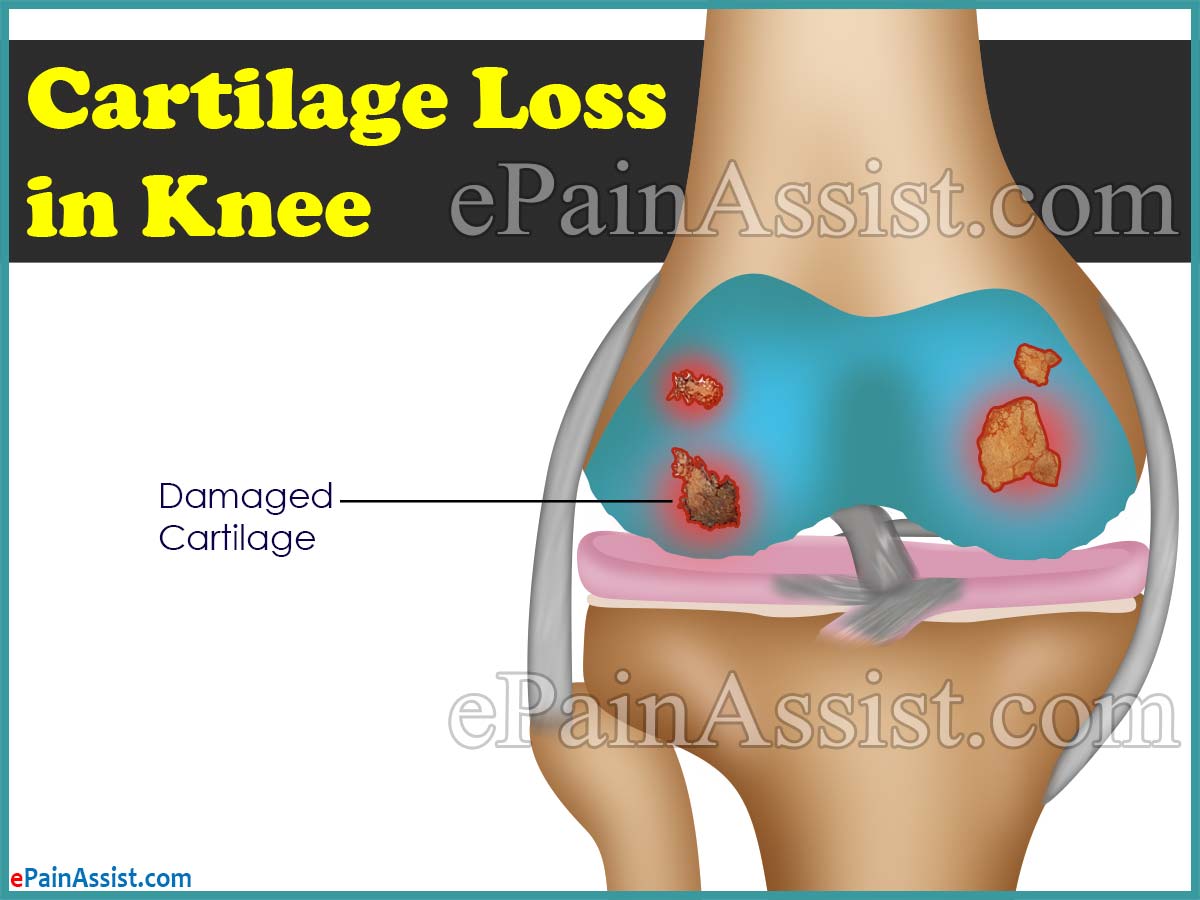Cartilage in the knee, is an articular cartilage, which is a soft tissue that joins the bone and muscle and helps smooth movement of the knee joint. It acts as a shock absorber and supports the knee joint during high impact activities like running or jumping. The cartilage thus protects the knee joint, absorbs shock and spreads the force evenly, without causing damage to the joint.

Cartilage loss in knee or no cartilage in knee is a condition, in which the knee cartilage gets worn resulting in damage to the knee joint.1 Activities like jumping, playing, running and sports with direct impact on the knees, cause the cartilage to get worn out over a period of time.
Low impact activities like walking generally do not cause much pressure on the cartilage. However, if the knee joint is previously injured, with ligament strain, meniscal tears or other sports injuries, walking and bending the knees can exert great pressure on the joint. This can cause damage to the torn cartilage, which can lead to further deterioration of the cartilage with continued wear and tear of the joint.
What Can Cause Cartilage Loss in Knee or No Cartilage in Knee?
The articular cartilage in the knee, if damaged or injured causes discomfort in the joint. Losing cartilage in knee is a common occurrence in people suffering from arthritis. This results from wearing out of the cartilage due to overuse of the knee joint for many years. Sports persons or those with a history of knee injuries or trauma to the knee may too have cartilage deterioration, which usually get torn due to injuries.
Cartilage is an avascular structure, means it does not have blood supply of its own. Hence, once the cartilage is damaged, it does not heal on its own and may cause pain and discomfort in the joint.
Knee osteoarthritis is a condition in which the knee cartilage, due to repeated overuse of the knee joint, gets worn out causing cartilage loss in knee or leading to no cartilage in knee. The knee cartilage begins to break down resulting in open areas, which causes the bones of the thigh and leg to rub against each other. This cartilage loss in knee or no cartilage in knee results in joint pain, swelling and also limits the movement of the knee joint.
Inflammatory arthritis like rheumatoid arthritis, too causes an inflammatory reaction, which leads to pain and swelling of the knee joint, as the synovial lining gets irritated. Lost knee cartilage cannot be made up and hence such conditions often remain progressive due to continued use of the knee joint.
Articular knee cartilage damage is classified into grades based on the severity of loss of cartilage in knee.
- Grade 0 is a normal healthy cartilage in the knee
- Grade 1 is when the cartilage in the knee shows damage in a spot
- Grade 2 is presence of minor tears in the cartilage of knee
- Grade 3 is presence of deep lesions in the cartilage affecting most part of cartilage in the knee
- Grade 4 is when the underlying bone gets exposed due to cartilage loss in knee or no cartilage in knee
How is Cartilage Loss in Knee or No Cartilage in Knee Diagnosed?
Whether it is injury or a joint condition, cartilage loss in knee needs to be evaluated by taking a thorough clinical history. Signs of injury and inflammation in the knee joint as well as other areas is noted. Loss of cartilage in the knee or no cartilage in knee often causes a painful reaction and the person has a swollen knee, which is unable to bear weight. Person with cartilage loss in the knee or no cartilage in knee may experience locking of the knee, if a torn piece of cartilage is disturbing the normal joint movement. The knee joint may also make sounds called crepitus on movement, these are best felt by placing palm over the knee when moving it.
Apart from clinical examination, imaging studies may be required to confirm the diagnosis. As knee cartilage is a soft tissue structure, X-rays may not be helpful to identify cartilage loss and often a magnetic resonance imaging (MRI) is ordered.2
What is the Treatment for Cartilage Loss in Knee or No Cartilage in Knee?
Treatment for knee cartilage damage is based on severity and the cause of cartilage loss in knee.
Medical management for cartilage loss in the knee or no cartilage in knee includes resting the knee joint and elevation to control swelling. In acute injuries, application of ice and compression with bandage may be advised. Medicines like non-steroidal anti-inflammatory drugs (NSAIDs) help to reduce pain and swelling associated with cartilage loss in the knee or no cartilage in knee. Certain nutritional supplements and steroid injection may be considered with advice of the physician.
Physiotherapy treatment that involves local application of heat and ice, ultrasound, etc. may be helpful for treating cartilage loss in the knee or no cartilage in knee. Therapeutic exercise to strengthen the muscles around knee joint, help to prevent further injuries and improves overall strength of the joint. Knee braces for cartilage loss in the knee or no cartilage in knee can be used to provide support to the knee joint. Weight control, regular exercise and modification of activities are an important conservative treatment approach for cartilage loss in the knee or no cartilage in knee.
Surgical treatment for cartilage loss in the knee involves use of various techniques like
- Arthroscopic lavage and debridement – The torn off cartilage is shaved off using an arthroscope.
- Marrow stimulation – Small holes are made into the bone under the damaged cartilage, to stimulate the marrow, which can help to produce new cartilage.
Other sophisticated techniques include using healthy cartilage from other joints, implanting newly regenerated cartilage cells or artificial scaffolds, etc. but each carry their own risks and benefits and should be well evaluated.
Also Read:
